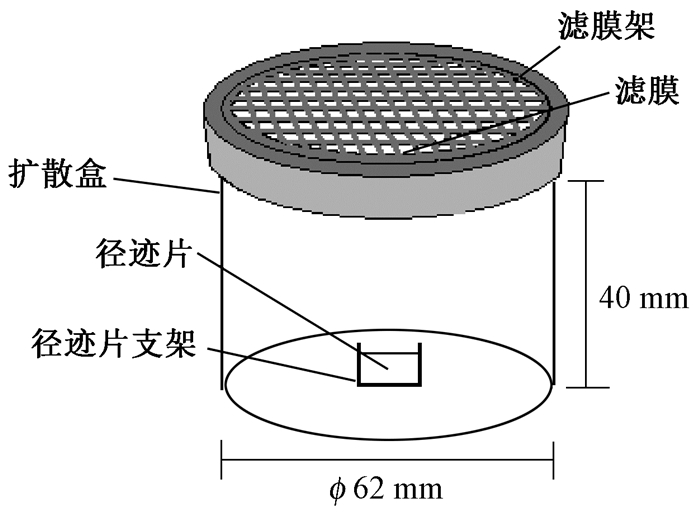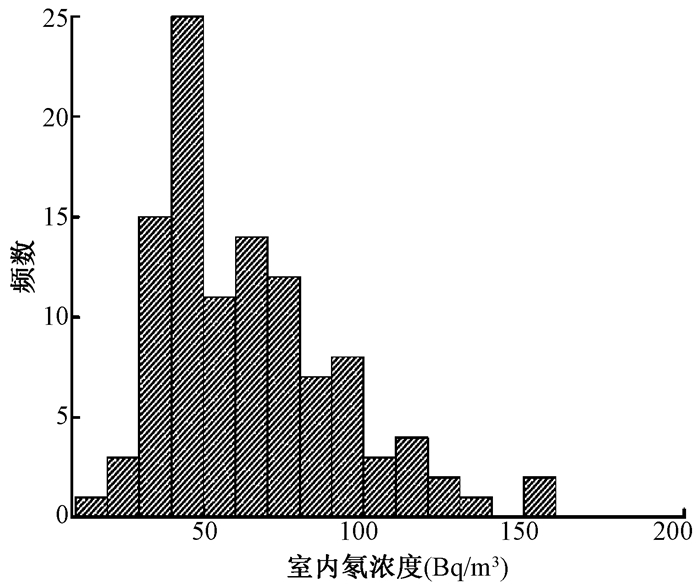2. 518049 深圳市建筑科学研究院股份有限公司
2. Shenzhen Institute of Building Research, Shenzhen 518049, China
随着城市现代化进程和多层和高层结构建筑的需要,掺工业废渣的建筑材料和加气混凝土砌块由于具有轻质、高强、节能等特点,被广泛用于现代建筑中。新型建筑材料的使用导致我国居室氡浓度呈现上升趋势[1, 2]。最新研究资料表明,2000年以后,我国建造的房屋室内氡浓度是20世纪60年代建造房屋的1.5倍[2]。居民室内氡的照射问题进一步引发人们关注。本研究选择深圳市近20多年建造的低层、多层、中高层和高层结构住宅,采用固体径迹法累积测量室内氡浓度,初步了解深圳市新建住宅室内氡水平及分布特征,为公众天然辐射照射提供基础数据。
材料与方法1. 调查对象:我国《民用建筑设计通则》(GB 50352-2005)[3]将住宅建筑依层数划分为低层住宅1~3层,多层住宅4~6层,中高层住宅7~9层,10层及以上为高层住宅。本次调查低层、多层、中高层设计住宅共22户,高层设计住宅86户,共108户住宅,建筑年代为1990—2015年。测量点覆盖深圳市的7个行政区,福田区、龙岗区、龙华新区、罗湖区、南山区、坪山新区和宝安区,分别占总测量点的25%、16%、22%、5%、18%、6%和8%。每户布放1个累积探测器,绝大多数布放在卧室,距离墙面30 cm以上,正常居住条件测量。布放时间为2015年7—10月份,暴露时间为3个月。
2.测量方法:采用固体径迹探测器累积测量室内氡浓度。探测器采用本实验室研制的LIH型氡探测器,结构见图 1所示。固体径迹材料采用日本FUKUVI化学公司生产的CR-39,探测器回收后,CR-39 采用6.25 mol/L的NaOH溶液80℃蚀刻8 h,然后用显微镜测读分析。

|
图 1 LIH型氡探测器结构 Figure 1 The construction of radon detector |
3.质量控制:LIH型探测器在南华大学标准氡室刻度,刻度系数为4.8 径迹·cm-2·(kBq·m-3·h)-1。该探测器曾与日本化学分析中心(JCAC)的Raduet探测器在日本放射线医学综合研究所(NIRS)标准氡室和南华大学标准氡室进行了比对,LIH探测器的测量结果与标准氡室的参考值相对百分偏差为2.8%~5.6%[4]。
4. 统计学处理:数据以x± s表示。采用SPSS 16.0进行数据分析和统计学检验,正态性检验采用Shapiro-Wilk检验,P > 0.05为差异有统计学意义。
结果1.室内氡浓度及分布:本次调查深圳市居民住宅共108户,室内氡浓度算数均值为64 Bq/m3,几何均值为58 Bq/m3,范围15~155 Bq/m3。深圳不同行政区域室内氡浓度见表 1,宝安区室内氡浓度均值最低,为50 Bq/m3,坪山新区室内氡浓度均值最高,为87 Bq/m3。
|
|
表 1 深圳不同行政区域室内氡浓度(Bq/m3) Table 1 Indoor radon concentration in different districts in Shenzhen(Bq/m3) |
深圳室内氡浓度频数分布见图 2。室内氡浓度 > 50 Bq/m3的测量点有62个,占总数的57.4%;室内氡浓度 > 100 Bq/m3的测量点有12个,占总数的11.1%。Shapiro-Wilk检验表明,深圳室内氡浓度频数分布呈对数正态分布(w=0.991,P > 0.05)。

|
图 2 深圳室内氡浓度频数分布 Figure 2 The frequency distribution of indoor radon concentrations in Shenzhen |
2.不同建筑年代房屋室内氡浓度比较:本次调查房屋建筑年代为1990—2015年,划分为3组,不同建筑年代房屋室内氡浓度结果列于表 2。由表 2可知,1990—1999年建筑的房屋室内氡浓度室内氡浓度均值最高,2010—2015年建筑的房屋室内氡浓度均值最低,室内氡浓度随建筑年代呈降低的趋势。
|
|
表 2 深圳不同建筑年代房屋室内氡浓度(Bq/m3) Table 2 Comparison of radon concentrations in dwellings at different building ages in Shenzhen |
3.不同楼层室内氡浓度比较:本次调查测量点覆盖楼层范围为1~33层,划分为4组,不同楼层室内氡浓度结果列于表 3。由表 3可知,1~3层室内氡浓度最高,为72 Bq/m3,除10层及以上,室内氡浓度随楼层的升高呈降低趋势。
|
|
表 3 深圳不同楼层住宅氡浓度分布(Bq/m3) Table 3 Comparison of radon concentrations in dwellings with different floors in Shenzhen |
讨论
本次调查深圳市居室108户,覆盖了深圳市的7个行政区,室内氡浓度算数均值为64 Bq/m3,几何均值为58 Bq/m3。2007年,有研究报道了我国26个主要城市室内氡浓度,其中,深圳市室内氡浓度算数均值为47 Bq/m3[5]。本次调查比以往深圳室内氡浓度调查相比,升高了35%。本次调查10层及以上的高层设计住宅有86个测量点,为框架结构,墙体材料采用新型建筑材料加气混凝土。加气混凝土具有质轻、保温隔热性能好、抗震能力强、施工简便等优点,被高层建筑广泛应用。但是,加气混凝土由于采用了发泡技术,提高了孔隙度,导致建材氡析出率增加。葛黎明等[6]的研究表明,加气混凝土砌块氡析出率明显高于粉煤灰砖、煤矸石砖和黏土砖。因此,本次调查深圳市室内氡浓度比以往调查升高的原因,主要与高层建筑的新型建筑材料氡析出率高有关,导致室内氡浓度增加。
近40年,伴随着我国建筑材料工业迅速发展和新型建筑材料的产生,建筑材料控制标准不断完善。从70年代以后,我国大量的工业废渣被用于建筑材料,如煤渣砖、粉煤灰砖、煤矸石砖等,研究表明,其镭含量明显高于土壤镭含量[7]。2001年我国发布了建筑材料放射性核素限量标准[8],对建材的内照射指数镭含量和外照射指数进行了控制。2009年,刘福东等[9]研究表明,加工工艺不同,即使是生产同类建筑材料,成品建筑材料的放射性核素镭活度浓度相近,但是,氡析出率的差别很大。随后,我国《民用建筑工程室内环境污染控制规范》GB 50325-2010新增加了建材放射性氡析出率控制指标[10],规定了民用建筑工程所使用的加气混凝土和空心率 > 25%的空心砖、空心砌块等建筑主体材料其表面析出率限量为≤0.015 Bq/(m2·s)。本次调查发现,近20多年,房屋室内氡浓度随建筑年代呈现降低的趋势,其原因可能与我国建筑材料放射性标准的不断完善有关。
不同楼层室内氡浓度分析表明,1~3层室内氡浓度最高,除10层及以上,室内氡浓度随楼层的升高呈降低趋势。通常,房屋室内氡浓度主要受房屋地基周围土壤和建筑材料的影响,随着楼层的增加,地基周围土壤的影响逐渐下降,建筑材料成为室内氡主要的来源。因此,室内氡浓度随楼层的升高呈降低趋势。此外,室内氡浓度还受自然通风的影响。低层和多层设计住宅大多户型可以南北通透,自然通风效果较好;10层及以上高层设计住宅多为单元式住宅和塔式住宅,单朝向户型较多,自然通风效果较差[11]。本次调查10层及以上室内氡浓度较高,可能与10层及以上高层设计住宅自然通风效果差有关。
我国新颁布GB/T 16146-2015《室内氡及其子体控制要求》规定,新建建筑物室内氡浓度设定的年均氡浓度目标水平为 100 Bq/m3[12]。本调查深圳住宅108个点,有12个点 > 100 Bq/m3,其中4个点分布在1~3层,2个点分布在4~6层,6个点分布在10层以上,室内氡浓度最高值155 Bq/m3位于12层。研究表明,高层建筑室内氡有60%~70%来源于建筑材料[13, 14]。因此,深圳室内氡污染的问题主要存在于高层建筑,治理的关键在于控制建筑材料。
综上所述,本次调查比以往深圳室内氡浓度调查相比升高了35%,主要与高层建筑的新型建筑材料氡析出率高有关。建议继续加强完善建材放射性标准,从源头控制室内氡浓度;加强高层住宅的自然通风,降低室内氡的辐射危害。
利益冲突 本研究进行"室内氡污染控制与治理关键技术"相关研究,本人与本人家属、其他研究者,未因进行该研究而接受任何不正当的职务或财务利益,在此对研究的独立性和科学性予以保证作者贡献声明 武云云负责数据分析、论文撰写和修改;孙浩和刘丹负责室内空气氡水平调查表、探测器布放和回收;尚兵和崔宏星负责提出研究思路、设计研究方案、数据处理
| [1] | 尚兵, 崔宏星, 吴锦海, 等. 我国室内氡水平及影响因素的研究[C]. 第二次全国天然辐射照射与控制研讨会论文汇编, 北京, 2005. 北京:中国核学会,中国环境科学学会, 2005: 31-32. Shang B, Cui HX, Wu JH, et al. Study on indoor radon level and influence factor in China[C]. The second national seminar on natural radiation irradiation and control, Beijing, 2005. Beijing: China Nuclear Society, Chinese Society for Environmental Sciences, 2005: 31-32. |
| [2] | 王春红, 潘自强, 刘森林, 等. 我国部分地区居室氡浓度水平调查研究[J]. 辐射防护, 2014,34 (2) :65–73. doi:10.3969/j.issn.1000-8187.2014.02.001 Wang CH, Pan ZQ, Liu SL, et al. Investigation on indoor radon levels in some parts of China[J]. Radiat Prot, 2014, 34 (2) :65–73 . doi:10.3969/j.issn.1000-8187.2014.02.001 |
| [3] | 中华人民共和国住房和城乡建设部,中华人民共和国国家质量监督检验检疫总局.50352-2005 民用建筑设计通则 .北京:中国建筑工业出版社,2005. Ministry of Housing and Urban-Rural Development of the People's Republic of China. 50352-2005 General Administration of Quality Supervision. Inspection and Quarantine of the People's Republic of China. Code for design of civil buildings .Beijing:China Building Industry Press,2005. |
| [4] | 崔宏星, 尚兵. α径迹氡探测器的刻度与质量控制[J]. 中国辐射卫生, 2006,15 (4) :507–508. doi:10.3969/j.issn.1004-714X.2006.04.070 Cui HX, Shang B. The α track radon detector calibration and the quality control[J]. Chin J Radiol Health, 2006, 15 (4) :507–508 . doi:10.3969/j.issn.1004-714X.2006.04.070 |
| [5] | 徐东群, 尚兵, 曹兆进. 中国部分城市住宅室内空气中重要污染物的调查研究[J]. 卫生研究, 2007,36 (4) :473–476. doi:10.3969/j.issn.1000-8020.2007.04.019 Xu DQ, Shang B, Cao ZJ. Investigation of key indoor air pollutants in residence in part of the cities in China[J]. J Hyg Res, 2007, 36 (4) :473–476 . doi:10.3969/j.issn.1000-8020.2007.04.019 |
| [6] | 葛黎明, 陈英民, 李福生, 等. 掺工业废渣新型墙体材料226Ra浓度与氡析出率测量[J]. 中华放射医学与防护杂志, 2008,28 (4) :404–405. doi:10.3760/cma.j.issn.0254-5098.2008.04.032 Ge LM, Chen YM, Li FS, et al. Measurement of 226Ra concentration and radon exhalation rate in new wall materials mixed with industrial residue[J]. Chin J Radiol Med Prot, 2008, 28 (4) :404–405 . doi:10.3760/cma.j.issn.0254-5098.2008.04.032 |
| [7] | 陈英民, 李福生, 许家昂, 等. 新型墙材用工业废渣中天然放射性核素分布研究[J]. 中国辐射卫生, 2006,15 (1) :20–22. doi:10.3969/j.issn.1004-714X.2006.01.009 Chen YM, Li FS, Xu JA, et al. Distribution of natural occurring radionuclides in some industrial residue used in new type wall materials[J]. Chin J Radiol Health, 2006, 15 (1) :20–22 . doi:10.3969/j.issn.1004-714X.2006.01.009 |
| [8] | 中华人民共和国国家质量监督检验检疫总局. GB 6566-2001 建筑材料放射性核素限量[S]. 北京:中国标准出版社,2002. General Administration of Quality Supervision, Inspection and Quarantine of the People's Republic of China. GB 6566-2001 Limit on radionuclide in building materials[S]. Beijng: Standards Press of China, 2002. |
| [9] | 刘福东, 潘自强, 刘森林, 等. 建筑材料氡析出率变化[J]. 原子能科学技术, 2009,43 (3) :271–274. Liu FD, Pan ZQ, Liu SL, et al. Variation of radon exhalation on building materials[J]. At Energy Sci Technol, 2009, 43 (3) :271–274 . |
| [10] | 中华人民共和国住房和城乡建设部, 中华人民共和国国家质量监督检验检疫总局. 50325-2010民用建筑工程室内环境污染控制规范[S]. 北京: 中国计划出版社, 2011. Ministry of Housing and Urban-Rural Development of the People's Republic of China. 50325-2010 General administration of quality supervision, inspection and quarantine of the People's Republic of China. Code for indoor environmental pollution control of civil building engineering[S]. Beijng: China Planning Press, 2011. |
| [11] | 赵凯.郑州地区高层住宅自然通风设计研究[D]. 郑州: 郑州大学, 2012. Zhao K. Study on Natural ventilation design of high-rise residential buildings in Zhengzhou[D]. Zhengzhou:Zhengzhou University, 2012. |
| [12] | 中华人民共和国国家质量监督检验检疫总局, 中国国家标准化管理委员会. GB/T 16146-2015室内氡及其子体控制要求[S]. 北京: 中国标准出版社, 2015. General Administration of Quality Supervision, Inspection and Quarantine of the People's Republic of China. Standardization administration of the People's Republic of China. GB/T 16146-2015 Requirements for control of indoor radon and its progeny[S]. Beijng: Standards Press of China, 2015. |
| [13] | Pal MVD. Radon transport in autoclaved aerated concrete [R]. Netherlands: Eindhoven University of Technology, 2004. |
| [14] | de Jong P, van Dijk W, van der Graaf ER, et al. National survey on the natural radioactivity and 222Rn exhalation rate of building materials in the Netherlands[J]. Health Phys, 2006, 91 (3) :200–210 . doi:10.1097/01.hp.0000205238.17466.1c |
 2016, Vol. 36
2016, Vol. 36


